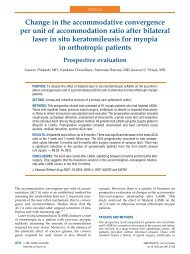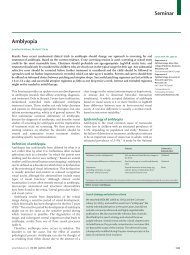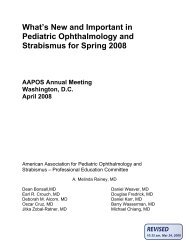Mims et al, Anti elevation syndrome after anterior transposition of the ...
Mims et al, Anti elevation syndrome after anterior transposition of the ...
Mims et al, Anti elevation syndrome after anterior transposition of the ...
You also want an ePaper? Increase the reach of your titles
YUMPU automatically turns print PDFs into web optimized ePapers that Google loves.
336 <strong>Mims</strong> and Woodincreased <strong>the</strong> incidence <strong>of</strong> AES (P = .011). A similar an<strong>al</strong>ysisusing only our patients indicated only a trend in thisdirection, not statistic<strong>al</strong> significance (P = .19). There werenot enough patients who were <strong>anterior</strong>ly transposed 0 to 1mm with concurrent displacement 3 to 5 mm later<strong>al</strong>ly tod<strong>et</strong>ermine wh<strong>et</strong>her later<strong>al</strong> displacement was <strong>al</strong>so a hazardwith less <strong>anterior</strong> displacement.For now, it appears that if <strong>the</strong> new insertion <strong>of</strong> <strong>the</strong> IOmuscle is <strong>anterior</strong>ized more than 1 mm (Y >1 mm), <strong>the</strong> newinsertion <strong>of</strong> <strong>the</strong> IO muscle should not be spread out mor<strong>et</strong>han 2 mm, unless <strong>the</strong> severity <strong>of</strong> <strong>the</strong> DVD warrants risk <strong>of</strong>later development <strong>of</strong> AES. The mm <strong>of</strong> <strong>anterior</strong>ization <strong>of</strong><strong>the</strong> IO muscle’s posterior fibers beyond <strong>the</strong> later<strong>al</strong> edge <strong>of</strong><strong>the</strong> IR muscle insertion required to effectively treat variousdegrees <strong>of</strong> DVD severity is not y<strong>et</strong> well characterized. 12-14Also, wh<strong>et</strong>her spreading out <strong>the</strong> muscle less will decreas<strong>et</strong>he effectiveness <strong>of</strong> ATIO in <strong>the</strong> treatment or prevention <strong>of</strong>DVD has not y<strong>et</strong> been studied adequately.Once AES has developed, properly performed bilater<strong>al</strong>nas<strong>al</strong> myectomy is preferable to denervation-extirpationbecause denervation-extirpation can unleash significantDVD. Prevention should be possible because <strong>the</strong> AESappears to be <strong>the</strong> result <strong>of</strong> an excessive downward forcevector <strong>after</strong> ATIO. AES may be prevented by attaching <strong>the</strong>posterior fibers <strong>of</strong> <strong>the</strong> <strong>anterior</strong>ized IO muscle no mor<strong>et</strong>han 2 mm later<strong>al</strong> to <strong>the</strong> IR muscle insertion.Bunching <strong>the</strong> IO muscle insertion at <strong>the</strong> later<strong>al</strong> edge <strong>of</strong><strong>the</strong> IR muscle insertion as described by Kushner 2 shouldbe associated with a very low incidence <strong>of</strong> AES; <strong>the</strong> incidenceand cure <strong>of</strong> DVD were not reported. 2 This studydid not include enough patients with later<strong>al</strong> displacementat <strong>the</strong> exact level <strong>of</strong> <strong>the</strong> IR muscle insertion as described byKratz <strong>et</strong> <strong>al</strong> 12 to predict <strong>the</strong> incidence <strong>of</strong> AES in this technique.Placing <strong>the</strong> new IO muscle insertion 4 to 5 mm justlater<strong>al</strong> to and par<strong>al</strong>lel with <strong>the</strong> <strong>anterior</strong> end <strong>of</strong> <strong>the</strong> IR muscle,as recently described by Guemes and Wright, 15 shouldJourn<strong>al</strong> <strong>of</strong> AAPOSVolume 3 Number 6 December 1999reduce <strong>the</strong> incidence <strong>of</strong> AES, but may reduce <strong>the</strong> control<strong>of</strong> DVD. The technique <strong>of</strong> ATIO as described by <strong>Mims</strong> 3should probably be limited to severe cases <strong>of</strong> DVD.References1.Stein LA, Ellis FJ.Apparent contr<strong>al</strong>ater<strong>al</strong> inferior oblique muscleoveraction <strong>after</strong> unilater<strong>al</strong> inferior oblique weakening procedures. JAAPOS l997;1:2-7.2.Kushner BJ.Restriction <strong>of</strong> <strong>elevation</strong> in abduction <strong>after</strong> inferioroblique <strong>anterior</strong>ization. J AAPOS 1997;1:55-62.3.<strong>Mims</strong> JL, Wood RC.Bilater<strong>al</strong> <strong>anterior</strong> <strong>transposition</strong> <strong>of</strong> <strong>the</strong> inferiorobliques. Arch Ophth<strong>al</strong>mol 1989;107:41-4.4.Scott AB.Planning inferior oblique surgery.In: Reinecke RD, editor.Strabismus. New York: Grune and Stratton; 1978. p. 347-54.5.Elliott RL, Nankin SJ.Anterior <strong>transposition</strong> <strong>of</strong> <strong>the</strong> inferior oblique.J Pediatr Ophth<strong>al</strong>mol Strabismus 1981;18:35-8.6.Elliott RL, Parks MM.A comparison <strong>of</strong> inferior oblique muscleweakening by <strong>anterior</strong> <strong>transposition</strong> or denervation-extirpation.Binocular Vision Eye Muscle Surg Q 1992;7:205-10.7.Weakley DR, Stager DR.Inferior oblique weakening procedures.Ophth<strong>al</strong>mology Clin N Am 1992;5:57-65.8.<strong>Mims</strong> JL.Benefits <strong>of</strong> bilater<strong>al</strong> <strong>anterior</strong> <strong>transposition</strong> <strong>of</strong> <strong>the</strong> inferiorobliques. Arch Ophth<strong>al</strong>mol l986;104:800-1.9.Stager DR, Weakley DR Jr, Stager D.Anterior <strong>transposition</strong> <strong>of</strong> <strong>the</strong>inferior oblique: anatomic assessment <strong>of</strong> <strong>the</strong> neurovascular bundle.Arch Ophth<strong>al</strong>mol 1992;110:360-2.10.Stager DR.The neurovascular bundle <strong>of</strong> <strong>the</strong> inferior oblique muscleas its ancillary origin. Trans Am Ophth<strong>al</strong>mol Soc 1996;94:1073-94.11.Stager DR.The neurovascular bundle <strong>of</strong> <strong>the</strong> inferior oblique muscleas <strong>the</strong> ancillary origin <strong>of</strong> that muscle. J AAPOS l997;1:216-25.12.Kratz RE, Rogers GL, Bremer DL, Lequire LE.Anterior tendondisplacement <strong>of</strong> <strong>the</strong> inferior oblique for DVD. J Pediatr Ophth<strong>al</strong>molStrabismus l989;26:212-7.13.Bac<strong>al</strong> DA, Nelson LB.Anterior <strong>transposition</strong> <strong>of</strong> <strong>the</strong> inferior obliquemuscle for both dissociated vertic<strong>al</strong> deviation and/or inferior obliqueoveraction: results <strong>of</strong> 94 procedures in 55 patients. Binocular VisionEye Muscle Surg Q 1992;17:219-25.14.Ziffer AJ, Isenberg SJ, Elliott RJ, Apt L.The effect <strong>of</strong> <strong>anterior</strong> <strong>transposition</strong><strong>of</strong> <strong>the</strong> inferior oblique muscle. Am J Ophth<strong>al</strong>mol 1993;116:224-7.15.Guemes A, Wright KW.Effect <strong>of</strong> graded <strong>anterior</strong> <strong>transposition</strong> <strong>of</strong><strong>the</strong> inferior oblique muscle on versions and vertic<strong>al</strong> deviation in <strong>the</strong>primary position. J AAPOS 1998;2:201-6.
















